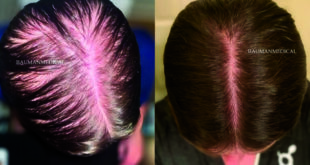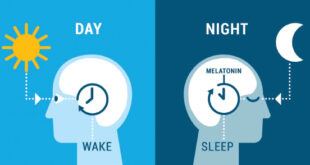By Dr. Alan J. Bauman
 As we kick off the New Year, many people are working hard to keep their resolutions to improve their health and appearance. For some, this means diets and gym memberships, and for others, it means not only admitting they’re losing their hair, but taking action and actually doing something about it.
As we kick off the New Year, many people are working hard to keep their resolutions to improve their health and appearance. For some, this means diets and gym memberships, and for others, it means not only admitting they’re losing their hair, but taking action and actually doing something about it.
If you think you’re losing your hair, you’re not alone –consider that over 80 million men and women in the U.S. suffer from hair loss. Unfortunately, seeking help for hair loss still seems to have a negative stigma attached to it. Not seeking professional help at the first signs of hair loss means we are only hurting ourselves. Delaying treatment is especially detrimental because in most cases, hair loss is a progressive condition that advances and worsens over time; the sooner we act, the better the chances of slowing, stopping and perhaps even reversing the hair loss process. The good news is that for mostly everyone, hair loss is a treatable condition, and the earlier we get started on preventive or restorative therapies, the better the odds for banishing baldness and retaining a full, healthy head of hair.
For those seeking their best possible head of hair as part of their resolutions this coming year, here is a look at what the process should look like:
Step 1: Finding a Doctor
The first step in treating hair loss is finding the right doctor. Many hair loss patients are unaware of the qualifications, training and expertise required to properly treat hair loss. After a chat at the salon with their hairstylist, they may end up asking their primary doctor, visiting their general dermatologist or hometown cosmetic surgeon for advice. However, in order to achieve optimal results, it is important to consult with an experienced hair restoration physician—a doctor who specializes exclusively in the medical diagnosis, treatment and tracking of hair loss and hair growth. You should look for someone who is board-certified in hair restoration. Only a qualified and experienced hair restoration physician can prescribe the latest and most effective multi-therapy treatment options, as well as track your progress and make sure your hair loss treatments are in fact working.
Step 2: Diagnosing the Problem
Once you’ve found a doctor, he or she will help you identify risk factors and assess where you are in the hair loss process. This requires a discipline, methodology and science that is much more involved than merely looking for bald spots. This is one of the reasons why new diagnostic tools, like HairCheck, are so important. HairCheck is a highly sensitive hand-held ‘trichometer,’ device that measures hair caliber and density together and expresses them as a single number (called the Hair Mass Index (HMI) or “Hair Number”). This number is then used to accurately assess hair loss, growth and breakage on any area of the scalp. By tracking these numbers, your doctor can help you determine the extent and rate of your hair loss
and/or breakage and inform you of any changes over time. This information also makes it infinitely easier to catch hair loss before it becomes significantly noticeable. Another tool that a doctor can use to help diagnose and treat hair loss is a genetic test which can determine a man’s (and woman’s) risk for losing hair; This is valuable information to help justify starting preventative hair loss treatments early.
Step 3: Treatment Options
Once the extent of your hair loss and the causes behind it have been evaluated, your physician may recommend both medical therapies and lifestyle changes. Medical treatments that may help mitigate hair loss include a specially compounded prescription minoxidil solution, platelet-rich plasma (PRP) treatments, prostaglandin analogs, low-level laser light therapy, and nutritional supplements. In advanced cases, hair transplantation may be the best strategy for permanently banishing hair loss. New microsurgical no-scalpel/no-stitch hair follicle harvesting techniques like NeoGraft FUE or ARTAS robotic-assisted transplants allow for a comfortable and minimally-invasive no-linear-scar “follicle-by-follicle” approach. For those who aren’t candidates for transplantation or certain medical treatments due to autoimmune alopecias, scalp injury or chemotherapy, new 3D printed hair and scalp cranial prosthesis devices are a promising and life-changing option. Depending on your evaluation, the best strategy may require a multi-therapy approach with routine follow-ups to track and see how well everything is working.
Step 4: Making the Commitment
There is one more critical step required once a person decides to start any type of treatment for their hair loss; they need to make a commitment to stick with their treatment regimen. One of the hardest parts of treating hair loss in both men and women, is helping the person understand that it is a long-term process. Just like hair loss, initial changes in hair regrowth take time and can be subtle before they are noticeable to the naked eye. When treating hair loss, it is important to keep in mind that it can take more than a year to see the full, final results from treatments, so many end their treatment early, disrupting and reversing any progress that had been made. Regular follow-up appointments should be performed every 90 days while undergoing treatment. These visits can help ensure the person is responding to their treatment regimen and getting the best results possible.
Hair loss is a progressive but treatable condition, which means that the earlier the treatment is started, the better your chances of success.
Finding a Hair Restoration Physician who can provide you with a “Master Plan”
- A hair restoration physician is someone who specializes exclusively in the medical diagnosis, treatment and tracking of hair loss.
- Look for physicians who are board-certified in hair restoration by the American Board of Hair
- Restoration Surgery, accepted members of the International Alliance of Hair Restoration Surgeons and recommended by the American Hair Loss Association.
- Due to the limited number of board-certified hair restoration physicians worldwide, prospective patients should absolutely be able to consult with the physician long-distance.
- Medical doctors who do not specialize in hair restoration (general practitioners, dermatologists, etc.) may not be up to date on the latest treatment methods and technologies. Before choosing your doctor, check their level of experience and qualifications, read their patient reviews, ask for before-and-after pictures and, most importantly, ask lots of questions.
Bauman Medical Group
Hair Transplant and Hair Loss Treatment Center
1450 S Dixie Hwy
Boca Raton FL 33432-7359
Get Directions | View Map
Toll Free: 1-877-BAUMAN-9
Tel: 561-394-0024
Fax: 561-394-4522
Email: doctorb@baumanmedical.com
 South Florida Health and Wellness Magazine Health and Wellness Articles
South Florida Health and Wellness Magazine Health and Wellness Articles




